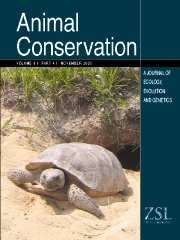Crossref Citations
This article has been cited by the following publications. This list is generated based on data provided by
Crossref.
Ranius, Thomas
and
Jansson, Nicklas
2000.
The influence of forest regrowth, original canopy cover and tree size on saproxylic beetles associated with old oaks.
Biological Conservation,
Vol. 95,
Issue. 1,
p.
85.
Ranius, T.
and
Wilander, P.
2000.
Occurrence of Larca lata H.J. Hansen (Pseudoscorpionida: Garypidae) and Allochernes wideri C.L. Koch (Pseudoscorpionida: Chernetidae) in tree hollows in relation to habitat quality and density.
Journal of Insect Conservation,
Vol. 4,
Issue. 1,
p.
23.
Nilsson, Sven G.
2001.
Setting Conservation Targets for Managed Forest Landscapes.
p.
79.
Ranius, Thomas
2002.
Influence of stand size and quality of tree hollows on saproxylic beetles in Sweden.
Biological Conservation,
Vol. 103,
Issue. 1,
p.
85.
Ranius, Thomas
and
Jansson, Nicklas
2002.
A comparison of three methods to survey saproxylic beetles in hollow oaks.
Biodiversity & Conservation,
Vol. 11,
Issue. 10,
p.
1759.
Sverdrup, Harald
and
Stjernquist, Ingrid
2002.
Developing Principles and Models for Sustainable Forestry in Sweden.
Vol. 5,
Issue. ,
p.
443.
Ranius, Thomas
2002.
Osmoderma eremita as an indicator of species richness of beetles in tree hollows.
Biodiversity & Conservation,
Vol. 11,
Issue. 5,
p.
931.
Larsson, Mattias C.
Hedin, Jonas
Svensson, Glenn P.
Tolasch, Till
and
Francke, Wittko
2003.
Characteristic Odor of Osmoderma eremita Identified as a Male-Released Pheromone.
Journal of Chemical Ecology,
Vol. 29,
Issue. 3,
p.
575.
Jonsell, Mats
Schroeder, Martin
and
Larsson, Therese
2003.
The saproxylic beetleBolitophagus reticulatus: its frequency in managed forests, attraction to volatiles and flight period.
Ecography,
Vol. 26,
Issue. 4,
p.
421.
2004.
Ecology, Genetics and Evolution of Metapopulations.
p.
599.
Bouget, Christophe
and
Duelli, Peter
2004.
The effects of windthrow on forest insect communities: a literature review.
Biological Conservation,
Vol. 118,
Issue. 3,
p.
281.
Smith, Andrew B. T.
2004.
Clarification on the Nomenclatural Status of Six Genus-Group Names in the Tribe Trichiini (Coleoptera: Scarabaeidae: Cetoniinae).
The Coleopterists Bulletin,
Vol. 58,
Issue. 2,
p.
285.
Nilsson, Sven G.
Niklasson, Mats
Hedin, Jonas
Eliasson, Per
and
Ljungberg, Håkan
2006.
Biodiversity and Sustainable Forestry in Changing Landscapes-Principles and Southern Sweden as an Example.
Journal of Sustainable Forestry,
Vol. 21,
Issue. 2-3,
p.
11.
Gibb, H.
Pettersson, R.B.
Hjältén, J.
Hilszczański, J.
Ball, J.P.
Johansson, T.
Atlegrim, O.
and
Danell, K.
2006.
Conservation-oriented forestry and early successional saproxylic beetles: Responses of functional groups to manipulated dead wood substrates.
Biological Conservation,
Vol. 129,
Issue. 4,
p.
437.
Ranius, Thomas
2006.
Measuring the dispersal of saproxylic insects: a key characteristic for their conservation.
Population Ecology,
Vol. 48,
Issue. 3,
p.
177.
Schroeder, Leif Martin
Ranius, Thomas
Ekbom, Barbara
and
Larsson, Stig
2006.
Recruitment of saproxylic beetles in high stumps created for maintaining biodiversity in a boreal forest landscape.
Canadian Journal of Forest Research,
Vol. 36,
Issue. 9,
p.
2168.
Gibb, Heloise
Hjältén, Joakim
P. Ball, John
Atlegrim, Ola
Pettersson, Roger B.
Hilszczański, Jacek
Johansson, Therese
and
Danell, Kjell
2006.
Effects of landscape composition and substrate availability on saproxylic beetles in boreal forests: a study using experimental logs for monitoring assemblages.
Ecography,
Vol. 29,
Issue. 2,
p.
191.
Ranius, Thomas
2007.
Extinction risks in metapopulations of a beetle inhabiting hollow trees predicted from time series.
Ecography,
Vol. 30,
Issue. 5,
p.
716.
Davies, Zoe G.
Tyler, Claire
Stewart, Gavin B.
and
Pullin, Andrew S.
2008.
Are current management recommendations for saproxylic invertebrates effective? A systematic review.
Biodiversity and Conservation,
Vol. 17,
Issue. 1,
p.
209.
Matern, Andrea
Drees, Claudia
Meyer, Hartmut
and
Assmann, Thorsten
2008.
Population ecology of the rare carabid beetle Carabus variolosus (Coleoptera: Carabidae) in north-west Germany.
Journal of Insect Conservation,
Vol. 12,
Issue. 6,
p.
591.

